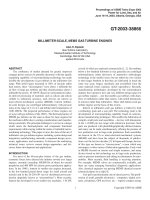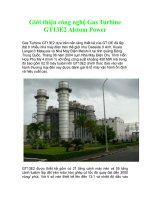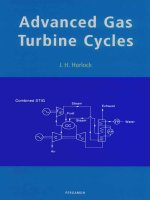Gas turbine fundamentels
Bạn đang xem bản rút gọn của tài liệu. Xem và tải ngay bản đầy đủ của tài liệu tại đây (10.16 MB, 135 trang )
ATA
GAS TURBINE FUNDAMENTELS
For training purposes only
JET ENGINES FOR AIRCRAFT
INTRODUCTION TO AIRCRAFT ENGINES
For Training Purposes O n ly
Controlled flight over long distances is only possible with a suitable aircraft
engine.
From the aerodynamics lesson, you remember that the lift force which keeps
an aircraft in the air, is only created when the aircraft moves through the
atmosphere fast enough.
It is clear, that the main function of an aircraft engine is to create the necessary
movement of the aircraft.
In addition, the aircraft engine also supplies hydraulic power, electric power and
bleed air for the pneumatic system.
Page 1
For Training Purposes O n ly
introduction to aircraft engines cont.
There are two different types of aircraft engines, the piston type engines and
gas turbine engines.
The first airplanes were powered by piston type engines that turned a propeller.
These engines are simple in design and more fuel efficient than gas turbine
engines but, piston type engines have some big disadvantages compared with
gas turbine engines.
The performance of piston engines decreases at higher altitudes. Therefore,
piston type engines are only used on very small aircraft.
Figure 2
Advantages/Disadvantages of Piston Type Engines
Page 2
For Training Purposes O n ly
GAS TURBINE ENGINES FOR AIRCRAFT
Gas turbine engines however, can operate at very high altitudes.
They easily provide thrust, torque and bleed air and they let aircraft fly at high
speeds.
There are different types of gas turbine engines on aircraft.
These are:
S turbojet engines
S turbofan engines
S turboprop engines
S and auxiliary power units
The turbofan engine is usually used on modern aircraft. This engine is better
because it makes high aircraft speeds possible with good engine efficiency.
The turbofan engine was developed from the turbojet engine.
Turbojet engines were the first type of gas turbine engines used on aircraft.
These engines gives very high aircraft speeds but these engines are very loud
because of the extremely high exhaust gas speeds. They also need too much
fuel.
Another type of engine which was developed from the turbojet is the turboprop
engine.
Turboprop engines are specially designed to produce shaft horsepower only,
which is used to drive a propeller. This engine type is usually installed on small
commuter aircraft. It is a good compromise between achievable aircraft speed
and fuel efficiency.
Another type of gas turbine engine that you will find on modern aircraft is the
’auxiliary power unit’. This small gas turbine engine is usually called ’APU. It is
used to supply the aircraft with electric and pneumatic power if engines are not
available. With the APU, the aircraft is independent of airport equipment.
Page 3
For Training Purposes O n ly
Turbo Jet
Turbo Fan
Auxiliary Power Unit
Turbo Prop
Figure 3
Types of Gas Turbine Engines
Page 4
PRINCIPLES OF JET PROPULSION
For Training Purposes O n ly
All aircraft engines work in the same way.
They create a propulsion force which moves the aircraft.
If you hold a water hose which is spraying water, you can feel that the hose
pushes in the opposite direction of the water which is spraying out of it.
Jet propulsion, is the propelling force which is generated in the opposite
direction to the flow of mass through the jet nozzle.
An engine which uses jet propulsion, is called a reaction engine. These engines
use Newton’s laws of motion which state that for every force which acts on a
body there is an opposite and equal reaction.
Page 5
For Training Purposes O n ly
Figure 4
Jet Propulsion Principle
Page 6
THE THRUST FORCE
For Training Purposes O n ly
A force is always created, when a body of mass is accelerated.
This body can be any kind of matter such as fluids and gasses or, it can be a
solid mass.
Figure 5
Force Equation
Page 7
For Training Purposes O n ly
the thrust force cont.
To accelerate air, the air pressure must be increased.
This can be done mechanically with a compressor or thermally by increasing
the volume of air when a fuel / air mixture is burned or heated. However, the
combination of both methods guarantees acceptable thrust for aircraft engines.
In 1913 the French engineer Rene Lorin patented a jet propulsion engine. This
engine uses compressed air coming from a piston engine and burns it in a
combustion chamber and then accelerates it through a jet nozzle.
You see that the idea of using jet propulsion to move an aircraft is simple but
the application was difficult.
Until the late 1930s, there was no compressor which could supply a continuous
and large enough airflow to produce a suitable thrust.
Figure 6
Air Acceleration Methods
Page 8
For Training Purposes O n ly
the thrust force cont.
Centrifugal flow compressors driven by turbines finally made propulsion
engines for aircraft possible.
In 1937, Hans--Joachim von Ohain built a gas turbine engine with a centrifugal
flow compressor driven by a radial turbine and in 1941, Frank Whittle built his
first engine which had a centrifugal flow compressor driven by an axial turbine.
Whittles’s and von Ohain’s engines became the base for all gas turbine
engines.
Note that these engines were only possible after the development of materials
that were heat resistant enough for continuous combustion.
CENTRIFUGAL FLOW COMPRESSOR
Figure 7
The first Gas Turbine Engines
Page 9
For Training Purposes O n ly
the thrust force cont.
Thrust force is generated by the acceleration of ambient air which is forced
through the engine.
This means that the thrust is determined by two parameters. One is the mass
of ambient air which is accelerated and the other parameter is the quantity of
acceleration itself.
The definition of mass is the quantity of matter in a body. In this example it is
the airflow through the engine in a given time and the acceleration of the airflow
is the difference between the outlet velocity of the air at the jet nozzle
compared with the inlet velocity of the air entering the engine.
The letter ”F” is the thrust force. Today this force is measured in NEWTONs or
KILO NEWTONs. 10 kN for example are equal to a force of 1020 kg or 2249
pounds pushing down because of the gravity of earth.
”m” is the mass of air. The dot above the letter m shows that this is a flow rate
in kg/s.
”V 1” is the velocity of the air at the engine inlet.
”V2” is the outlet velocity of the air the engine jet nozzle.
Page 10
For Training Purposes O n ly
Figure 8
The Thrust Force
Page 11
WHAT IS THRUST
For Training Purposes O n ly
On this test model we will now explore what thrust is.
You can see a small jet engine model which is free to move forward and
backwards.
The engine model is supplied with air by an external compressor. The quantity
of airflow to the engine can be changed by a control valve.
A pointer on the engine shows the generated thrust on a scale below. If the
airflow is constant, and you change the diameter of the jet nozzle the outlet
velocity changes.
If you install different jet nozzles on the engine model, you see what happens
to the thrust if the outlet velocity changes.
The nozzle with a small diameter creates a high outlet velocity and therefore a
high thrust.
A nozzle with a medium diameter creates a medium outlet velocity and therefore a medium thrust.
The nozzle with a large diameter creates a low outlet velocity resulting in a low
thrust.
Page 12
For Training Purposes O n ly
HIGH THRUST
LOW THRUST
Figure 9
Thrust Test Model
Page 13
For Training Purposes O n ly
what is thrust cont.
You can see here, that if you put a deflector plate into the outlet airflow the
thrust of the jet nozzle does not change.
This shows, that the thrust is generated by acceleration of airflow and not by
pushing against the atmosphere or some other object
Figure 10
Deflector Plate in Outlet Airflow
Page 14
ENVIRONMENTAL EFFECTS ON THRUST
For Training Purposes O n ly
There are four main environmental parameters that cause a change in the
thrust of a jet engine like:
S the ambient air pressure
S the air temperature
S the operating altitude
S and finally the air speed of the aircraft.
The most important factors that cause a change of the mass airflow are air
temperature and air pressure, because these factors determine the density of
air.
The density is the mass per unit of volume. In other words it is the number of
molecules in a given volume.
Generally the density is measured in kg per m3 or pounds per cubic foot.
When the density of a gas increases, there are more molecules in a given
volume and vice versa.
A lower air density creates lower thrust because the airflow contains less mass
than a high density airflow.
Page 15
For Training Purposes O n ly
AIR SPEED
Figure 11
Environmental Effects on Thrust
Page 16
For Training Purposes O n ly
environmental effects on thrust cont.
The air temperature changes the density.
The thrust of a jet engine decreases when the temperatures of the air increase.
Pressure changes of the ambient air also change its density and therefore the
thrust of an engine.
The higher the air pressure gets, the higher the resulting thrust is.
Figure 12
Relation Thrust vs. Air Pressure and Air Temperature
Page 17
For Training Purposes O n ly
environmental effects on thrust cont.
A much bigger effect on air pressure changes can be seen when the altitude
changes.
With increasing altitudes, the ambient pressure decreases and the temperature
decreases continuously until 36000 feet is reached.
From 36000 feet up to 65000 feet, the air temperature stays constant at
approximately -705° F.
The colder air temperatures at higher altitudes give a small increase in thrust
but the decrease in thrust is much bigger because of the decreasing air
pressure.
The thrust which results from the two opposite conditions is shown by the
highlighted curve on the diagram.
Page 18
For Training Purposes O n ly
Figure 13
Relation Thrust vs. Altitude
Page 19
For Training Purposes O n ly
environmental effects on thrust cont.
One factor that changes the thrust, is the quantity of the acceleration of the
airflow because of the speed of the aircraft.
When the speed of the aircraft increases, the thrust decreases. You can see
this in the downward slope of the thrust curve. This happens, because the
difference between the outlet velocity and the inlet velocity of the airflow
decreases when the speed of the aircraft increases.
Another factor of the airspeed causes an opposite change on the generated
thrust.
When the aircraft moves through the air, the airflow that is rammed into the
engine inlets increases the airflow through the engine. This increases the thrust
of the engine as shown on the upward sloping curve.
Therefore, the net effect of the airspeed on the thrust is a combination of thrust
decrease from acceleration effect and thrust increase from the ram effect.
Figure 14
Relation Thrust vs. Aircraft Speed
Page 20
THRUST ON TYPICAL AIRCRAFT ENGINES
All aircraft engines which you see here produce thrust by accelerating ambient
air.
However, the difference between them is how they do it.
A turbojet engine is designed for one purpose and this is to produce high
velocity gases. On these engines, all the gas energy which is not used to drive
the compressor and the accessories is converted into thrust.
The high outlet velocity of these engines gives high aircraft speeds, but turbojet
engines are extremely loud.
For Training Purposes O n ly
TURBO JET ENGINE
Figure 15
Thrust of a Turbojet Engine
Page 21
For Training Purposes O n ly
thrust on typical aircraft engines cont.
All other engines shown here have been based on the turbojet engine with the
primary reason to improve efficiency.
Turboprop engines produce their thrust by a small acceleration of a large
quantity of air with a propeller. The propeller can be driven directly from the
compressor shaft or by a free turbine and a long center drive shaft.
Note, that a reduction gear is always required to reduce the high gas turbine
engine rotation to speeds that can be managed by the propeller.
Turboprop engines convert all the gas energy into torque. They are very
efficient, but the propeller does not permit high aircraft speeds.
TURBOPROP ENGINE
Figure 16
Thrust of a Turboprop Engine
Page 22
For Training Purposes O n ly
thrust on typical aircraft engines cont.
The turbofan engine combines the best advantages of turbojet and turboprop
engines.
The turbofan engine is very much like a turboprop engine, but instead of the
propeller, this engine has a fan which is enclosed in a casing. Turbofan engines
are usually twin or triple spool engines. The fan is always driven by a turbine
via a drive shaft. Normally these engines do not have a reduction gear to
reduce the speed of the fan.
Turbofan engines convert a large part of the gas energy into torque to drive the
fan and the engine compressors. The remaining hot gas energy from the
airflow which discharges from the so called core engine is directly converted
into thrust.
The total thrust of the turbofan engine is the sum of the thrust developed by the
core engine and by the fan.
Page 23
For Training Purposes O n ly
TURBOFAN ENGINE
Figure 17
Thrust of a Turbofan Engine
Page 24









